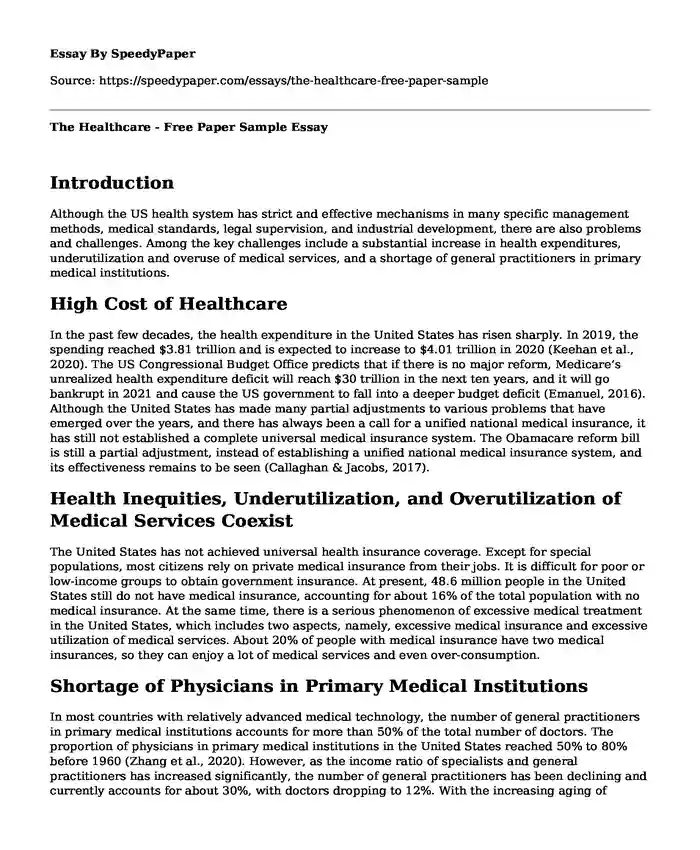
| Type of paper: | Essay |
| Categories: | United States Finance Healthcare Healthcare policy |
| Pages: | 3 |
| Wordcount: | 701 words |
Introduction
Although the US health system has strict and effective mechanisms in many specific management methods, medical standards, legal supervision, and industrial development, there are also problems and challenges. Among the key challenges include a substantial increase in health expenditures, underutilization and overuse of medical services, and a shortage of general practitioners in primary medical institutions.
High Cost of Healthcare
In the past few decades, the health expenditure in the United States has risen sharply. In 2019, the spending reached $3.81 trillion and is expected to increase to $4.01 trillion in 2020 (Keehan et al., 2020). The US Congressional Budget Office predicts that if there is no major reform, Medicare’s unrealized health expenditure deficit will reach $30 trillion in the next ten years, and it will go bankrupt in 2021 and cause the US government to fall into a deeper budget deficit (Emanuel, 2016). Although the United States has made many partial adjustments to various problems that have emerged over the years, and there has always been a call for a unified national medical insurance, it has still not established a complete universal medical insurance system. The Obamacare reform bill is still a partial adjustment, instead of establishing a unified national medical insurance system, and its effectiveness remains to be seen (Callaghan & Jacobs, 2017).
Health Inequities, Underutilization, and Overutilization of Medical Services Coexist
The United States has not achieved universal health insurance coverage. Except for special populations, most citizens rely on private medical insurance from their jobs. It is difficult for poor or low-income groups to obtain government insurance. At present, 48.6 million people in the United States still do not have medical insurance, accounting for about 16% of the total population with no medical insurance. At the same time, there is a serious phenomenon of excessive medical treatment in the United States, which includes two aspects, namely, excessive medical insurance and excessive utilization of medical services. About 20% of people with medical insurance have two medical insurances, so they can enjoy a lot of medical services and even over-consumption.
Shortage of Physicians in Primary Medical Institutions
In most countries with relatively advanced medical technology, the number of general practitioners in primary medical institutions accounts for more than 50% of the total number of doctors. The proportion of physicians in primary medical institutions in the United States reached 50% to 80% before 1960 (Zhang et al., 2020). However, as the income ratio of specialists and general practitioners has increased significantly, the number of general practitioners has been declining and currently accounts for about 30%, with doctors dropping to 12%. With the increasing aging of American society, if this development trend cannot be effectively intervened, the US general practitioner gap will reach 52,000 (20%) in 2025, and medical costs in the United States will continue to rise, thus affecting the quality of health services (Zhang et al., 2020).
Conclusion
The mistakes in national legislation and the inadequate health management system are the main reasons why the US health system faces many challenges. Drawing on the above-mentioned healthcare challenges in the United States, health care administrators must strive to achieve more efficient, equitable, and effective medical system. To transform Healthcare in the US, every citizen should be guaranteed the basic rights of health care, emphasizing the role of the government and primary medical institutions. Healthcare professionals should also be increased, and payment methods reformed to control medical care increase in expenses. Also, legislation must be strengthened to deal with medical accidents and disputes reasonably.
References
Callaghan, T. H., & Jacobs, L. R. (2017). The future of health care reform: What is driving enrollment?. Journal of health politics, policy and law, 42(2), 215-246.
Emanuel, E. J. (2016). How can the United States spend its health care dollars better?. Jama, 316(24), 2604-2606. https://natap.org/2016/AGE/jed160112.pdf
Keehan, S. P., Cuckler, G. A., Poisal, J. A., Sisko, A. M., Smith, S. D., Madison, A. J., ... & Hardesty, J. C. (2020). National Health Expenditure Projections, 2019–28: Expected Rebound In Prices Drives Rising Spending Growth: National health expenditure projections for the period 2019–2028. Health Affairs, 39(4), 704-714. https://www.healthaffairs.org/doi/full/10.1377/hlthaff.2020.00094
Zhang, X., Lin, D., Pforsich, H., & Lin, V. W. (2020). Physician workforce in the United States of America: forecasting nationwide shortages. Human Resources for Health, 18(1), 8.
https://link.springer.com/article/10.1186/s12960-020-0448-3.
Cite this page
The Healthcare - Free Paper Sample. (2023, Nov 25). Retrieved from https://speedypaper.com/essays/the-healthcare-free-paper-sample
Request Removal
If you are the original author of this essay and no longer wish to have it published on the SpeedyPaper website, please click below to request its removal:
- Mindfulness in a Professional Setting - Free Essay on Volunteering
- Research Proposal Paper Sample: Mental Health Screening in Prisons
- Free Essay: Impacts of Vaping
- Essay Sample on Impacts of Coronavirus on Airline Industries
- Paper Example: Communicating With Former Classmates During the Lockdown
- Addressing Educational Inequality, Controversies in Sex Education, and Solutions for Housing Segregation in the USA
- To What Extent is Democracy in America a Celebration of Democracy? - Essay Sample
Popular categories




